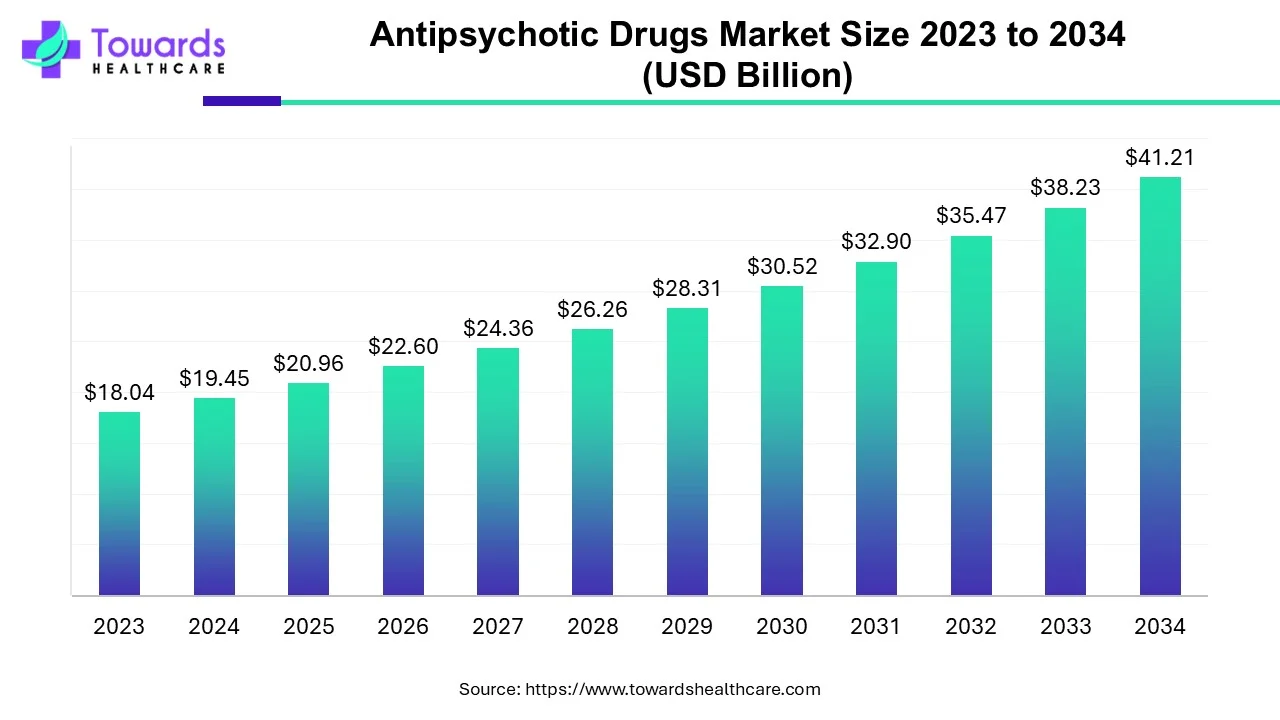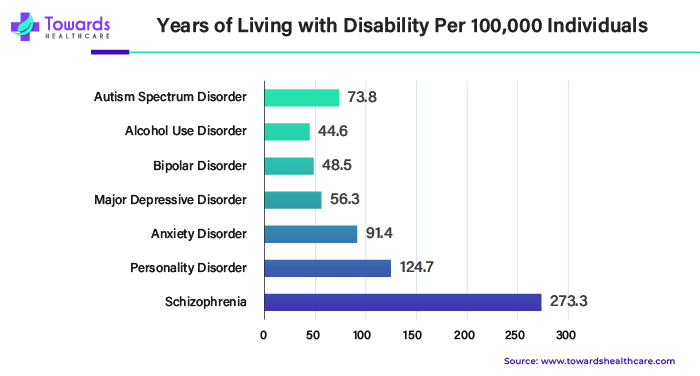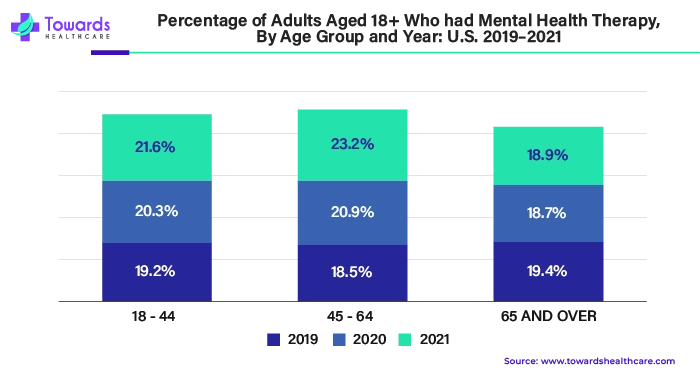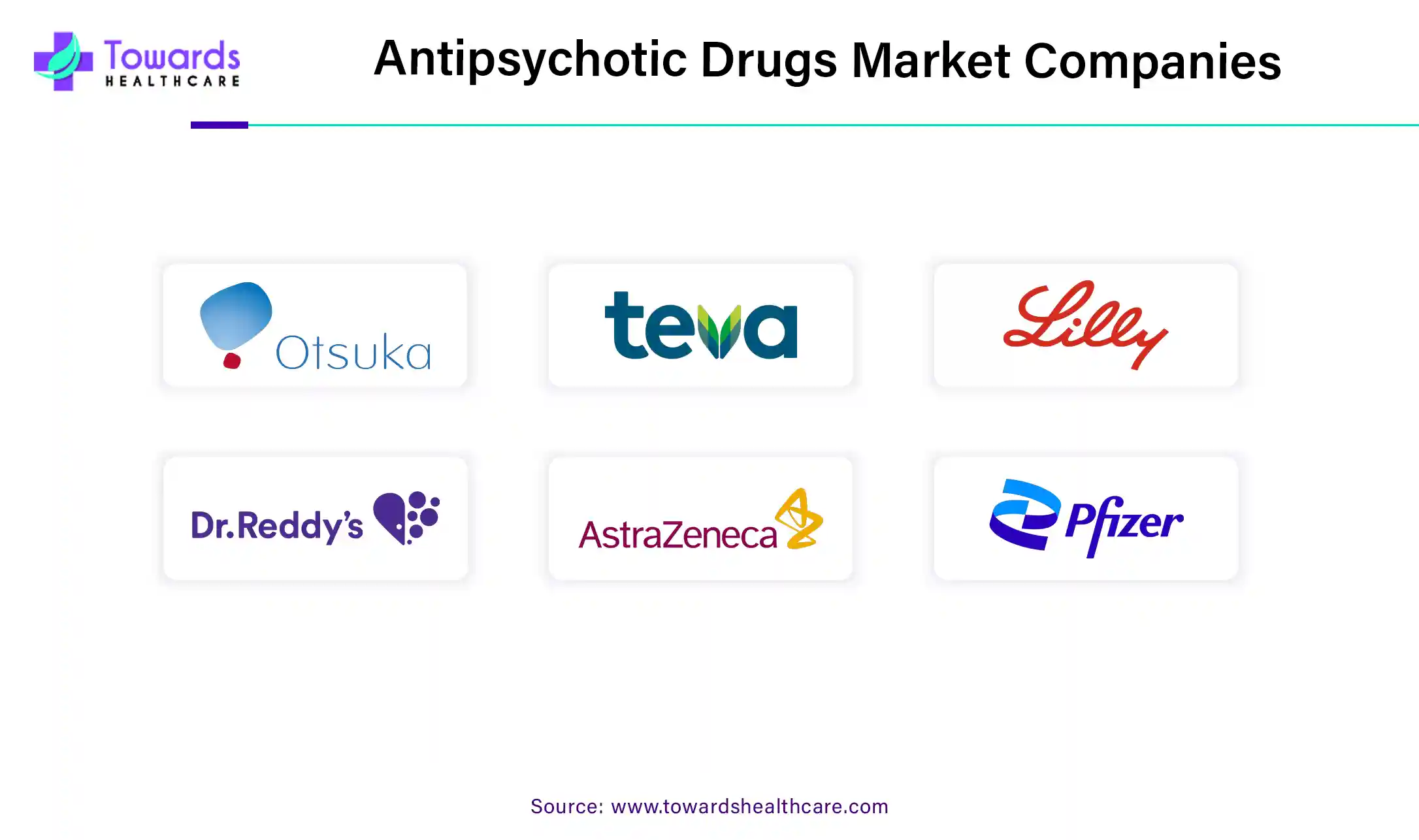November 2025

The antipsychotic drugs market is projected to reach USD 41.21 billion by 2034, expanding from USD 20.96 billion in 2025, at an annual growth rate of 7.8% during the forecast period from 2025 to 2034.

World’s 0.32% of the population accounting for around 24 million individuals are affected with schizophrenia.
Antipsychotic drugs also called neuroleptics are prominently used to reduce the symptoms associated with psychosis. Many symptoms, such as delusions and hallucinations, like paranoia and hearing voices, can be effectively reduced and controlled by antipsychotic medicines. Fear and severe agitation, such as those resulting from being threatened, nonsensical speech, confused thoughts, violent or disruptive behavior, or manic episodes can also be managed with antipsychotic drugs. Antipsychotic drugs act by blocking the action of dopamine and other neurotransmitters in the brain.
Currently marketed therapeutics include first and second-generation antipsychotic drugs. Major conditions treated with antipsychotic drugs include schizophrenia, dementia, bipolar disorder, depression, and other conditions. The two major uses of antipsychotics include the reduction of severe (acute) symptoms and the prevention of symptom relapses and hospitalization. Both generations of medicine are efficient but the newer ones have improved benefits with lessened side effects over the typical first-generation antipsychotics. Schizophrenia is one of the major conditions treated with antipsychotic drugs. The rising number of schizophrenia patients is one of the major growth factors for the antipsychotic drugs market.
For instance,
A clinical and research study was conducted by the Danish national health registries related to the disability caused by Schizophrenia. Researchers developed new predictions of the degree of disability linked to various mental health and substance use disorders by utilizing the wealth of medical data found in Danish national health registries.

Schizophrenia was found to be the most burdensome mental illness at both the individual and population levels by John McGrath, M.D., Ph.D., the Niels Bohr Professor at the National Centre for Register-based Research at Aarhus University in Denmark, and colleagues when they took into account the length of illness and degree of disability. After alcohol use disorders in males and anxiety disorders in women, personality disorders were the second most incapacitating conditions for both sexes. The Lancet Psychiatry published these findings.
McGrath and colleagues used data from the Danish Psychiatric Central Research Register to compute the YLD (years lived with disability) for 18 mental health and substance abuse problems. The YLD is derived by multiplying the duration of an illness by a predetermined impairment index ranging from 0 to 1. Though major depression was the most common problem in Denmark, schizophrenia was the largest cause of impairment from mental illness for both men and women, accounting for 273 years of life lost per 100,000 people. Personality problems were the second most debilitating, followed by anxiety disorders.
Clinical trials drive the antipsychotic drug industry by driving innovation, establishing proof of drug efficacy, and influencing treatment practices. As a result, the antipsychotic drug market has become more robust, and schizophrenia patients have a broader selection of treatment alternatives.
| Name of Study | Type of Study | Start Date |
| Anti-Inflammatory Challenge in Schizophrenia | Interventional | March 31, 2024 |
| Young Adults with Violent Behaviour During Early Psychosis | Interventional | February 29, 2024 |
| Tau Biomarkers in Late-onset Psychosis | Observational | February 16, 2024 |
| Enhanced Coordinated Specialty Care for Early Psychosis | Interventional | February 1, 2024 |
| Accelerated Transcranial Magnetic Stimulation for People with Schizophrenia Treated with Clozapine | Interventional | December 1, 2023 |
| Auditory Control Enhancement (ACE) in Schizophrenia | Interventional | September 5, 2023 |
| Restoring Spindle and Thalamocortical Efficiency in Early-Course Schizophrenia Patients Using Auditory Stimulation | Interventional | July 20, 2023 |
| Improving Cognition Through Telehealth Aerobic Exercise and Cognitive Training After a First Schizophrenia Episode | Interventional | May 23, 2023 |
| Deep Brain Stimulation in Treatment-Resistant Schizophrenia | Interventional | March 1, 2023 |
According to the MDPI’s published research article in January 2024, antipsychotic drug prescriptions have increased in Ireland in 2022. Ireland's population was 4.985 million in 2020, with a projected increase to 5.033 million in 2021 and 5.15 million by 2022. From 2020 to 2022, the number of prescriptions for psycholeptics climbed yearly, peaking at 328,572 in December 2020. In April 2021, Ireland had a minimum of 31,340 patients receiving at least one antipsychotic through payment systems. In 2021, 30.8% of the Irish population was registered under the GMS plan. Antipsychotics were prescribed to at least 1.9% of the 1.54 million medical card holders. The total ingredient cost of antipsychotics on GMS and DPS programs in 2021 was more than USD 26.6 million. A subsequent analysis found an increase in antipsychotic prescribing in the dementia and care home groups, which coincided with COVID-19 lockdowns and could have been attributable to antipsychotic prescribing for palliative care.
According to the U.S. Department of Health and Human Services, from 2019 to 2021, the proportion of adults who had undergone any kind of mental health treatment rose from 19.2% to 21.6% for adults of all ages and from 18.5% to 23.2% for those in the 18–44 age group in the U.S. From 2019 to 2021, the percentage of U.S. people who received mental health care climbed by approximately 5 percentage points, primarily among those aged 18-44. In 2021, 23.2% of adults between the ages of 18 and 44 received therapy.

Among people aged 18-44, mental health treatment grew over time for both men and women, non-Hispanic White and non-Hispanic Asian, and throughout metropolitan and nonmetropolitan locations. In 2021, the highest estimates for adults aged 18-44 were among women (28.6%) and non-Hispanic White people (30.4%).
This increase in treatment rates represents a positive step towards prioritizing mental health in the United States. However, additional effort is needed to ensure that everyone receives the care they require. The rising mental health conditions and increased demand for mental health treatments ultimately foster the anti-psychotic drugs market.
A rise in mental health disorders is one of the prominent reasons for increasing mental health treatments. This further augments the use of antipsychotic drugs and expands the antipsychotic drugs market. As mental health disorders are rising, there is an increasing demand for effective treatments is growing. In addition, an increased number of patients pool with conditions such as schizophrenia, depression, bipolar disorders, and other conditions significantly expands the antipsychotic drugs market growth. Furthermore, increased emphasis on early disease detection in mental health disorders results in the initiation of antipsychotic drug therapy recommended by doctors which in turn adds to the market growth. Moreover, the rising focus on R&D in antipsychotic drugs to detect novel formulations not only for managing but treating mental health disorders, accelerates the antipsychotic drugs market growth.
In recent years there has been an increase in the R&D, clinical trials, and product approvals in antipsychotic drugs which ultimately foster the growth of the antipsychotic drugs market. Scientists are working to develop novel therapeutics for the treatment of psychotic disorders such as schizophrenia, dementia, bipolar disorders, depression, and other diseases.
Here are some recent drug approvals of the antipsychotic drugs:
Rising product approvals significantly augment the market growth by availing advanced and more effective drugs for psychosis and related conditions.
Side effects such as tardive dyskinesia, weight gain, and sleepiness can greatly reduce a patient's motivation to take their prescription as prescribed. This can lead to symptom recurrence and hospitalization, which raises overall healthcare costs. Unwanted side effects can have a significant influence on a patient's daily life, including their ability to work, socialize, and maintain relationships. This can result in lower productivity and higher utilization of healthcare resources to manage side effects. In addition, managing side effects frequently necessitates additional medications or therapies, increasing the overall expense of treatment. Considering all the factors, the adverse effects of antipsychotic drugs are a prominent restraining factor for the market growth.
North America dominated the antipsychotic drugs market in 2023 due to the high prevalence of associated disorders, rise in healthcare costs, and strong existence of market players. Mental diseases such as schizophrenia and bipolar disorder are highly prevalent. In addition, leading biopharmaceutical companies are heavily involved in the development and marketing of these medications. Furthermore, healthcare spending is rather high, as is insurance coverage for mental health services. Government measures to raise mental health awareness and improve access to medication can have a big impact on the market. The availability of qualified mental health specialists and well-equipped healthcare facilities are essential for efficiently administering antipsychotic medicines. Individuals and families with higher disposable income can afford to use these drugs.
For instance,
Asia Pacific is estimated to grow at the fastest CAGR during the forecast period, particularly in developing nations like China and India. The many awareness campaigns about psychiatric disease and the rising number of mental illness cases in the area are anticipated to spur the use of these medications in the area.
In December 2024, Newron Pharmaceuticals S.p.A., a biopharmaceutical company focused on the development of novel therapies for patients with diseases of the central and peripheral nervous system, and EA Pharma Co., Ltd., a subsidiary of Eisai Co., Ltd., announced that they have entered into a license agreement to develop, manufacture and commercialize Newron’s innovative modulator of the excessive release of glutamate, evenamide, in Japan and other designated Asian territories.
In September 2024, the U.S. Food and Drug Administration approved Cobenfy capsules for oral use for the treatment of schizophrenia in adults. It is the first antipsychotic drug approved to treat schizophrenia that targets cholinergic receptors as opposed to dopamine receptors, which has long been the standard of care.

By Therapeutic Class
By Application
By Distribution Channel
By Geography
November 2025
November 2025
November 2025
November 2025